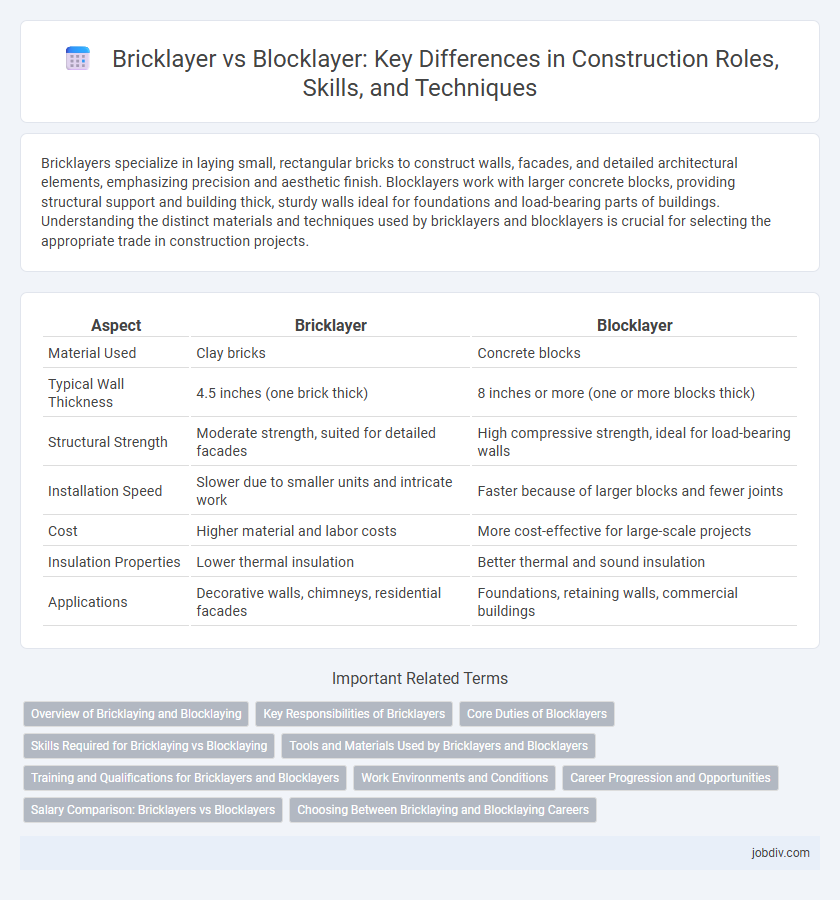Bricklayers specialize in laying small, rectangular bricks to construct walls, facades, and detailed architectural elements, emphasizing precision and aesthetic finish. Blocklayers work with larger concrete blocks, providing structural support and building thick, sturdy walls ideal for foundations and load-bearing parts of buildings. Understanding the distinct materials and techniques used by bricklayers and blocklayers is crucial for selecting the appropriate trade in construction projects.
Table of Comparison
| Aspect | Bricklayer | Blocklayer |
|---|---|---|
| Material Used | Clay bricks | Concrete blocks |
| Typical Wall Thickness | 4.5 inches (one brick thick) | 8 inches or more (one or more blocks thick) |
| Structural Strength | Moderate strength, suited for detailed facades | High compressive strength, ideal for load-bearing walls |
| Installation Speed | Slower due to smaller units and intricate work | Faster because of larger blocks and fewer joints |
| Cost | Higher material and labor costs | More cost-effective for large-scale projects |
| Insulation Properties | Lower thermal insulation | Better thermal and sound insulation |
| Applications | Decorative walls, chimneys, residential facades | Foundations, retaining walls, commercial buildings |
Overview of Bricklaying and Blocklaying
Bricklaying involves the precise placement of bricks using mortar to create durable walls, facades, and structural elements, emphasizing aesthetic and load-bearing qualities. Blocklaying focuses on assembling larger, lightweight concrete or cinder blocks to form strong, insulated, and cost-effective building components ideal for foundations and partitions. Mastery in both trades requires understanding material properties, joint techniques, and adherence to construction standards for optimal strength and longevity.
Key Responsibilities of Bricklayers
Bricklayers specialize in constructing walls, partitions, and other structures using bricks, focusing on precise alignment, leveling, and bonding with mortar to ensure durability and stability. They interpret construction drawings, measure materials accurately, and cut bricks to fit intricate designs and openings. Quality control, maintaining safety standards, and collaborating with other trade professionals are essential responsibilities to complete bricklaying projects efficiently.
Core Duties of Blocklayers
Blocklayers specialize in constructing walls and structures using large concrete blocks, focusing on precision in alignment, mortar application, and structural stability. Core duties include measuring and cutting blocks to fit specific designs, ensuring proper bonding patterns, and reinforcing walls with steel bars or other supports. Their work contributes significantly to the structural integrity and insulation properties of both commercial and residential buildings.
Skills Required for Bricklaying vs Blocklaying
Bricklayers require precision in handling smaller, uniform bricks, mastery of mortar mixing, and intricate pattern creation for aesthetic appeal, while blocklayers focus on larger concrete or cinder blocks demanding advanced strength skills and structural alignment expertise. Both trades necessitate proficiency in reading blueprints, using trowels, levels, and chisels, but bricklayers emphasize fine detail and textural finishes, whereas blocklayers prioritize speed and durability in load-bearing wall construction. Expertise in mortar consistency and joint uniformity is critical for bricklayers, contrasting with blocklayers who must ensure thermal insulation and reinforcement integration within blocks.
Tools and Materials Used by Bricklayers and Blocklayers
Bricklayers primarily use clay bricks and lime or cement-based mortar, employing tools such as trowels, brick hammers, and spirit levels to ensure precise alignment and bonding. Blocklayers work with larger concrete blocks or cinder blocks, utilizing masonry saws, jointers, and mortar boards to handle heavier materials and create thicker walls. Both trades rely on string lines and plumb bobs to maintain straight and level courses during construction.
Training and Qualifications for Bricklayers and Blocklayers
Bricklayers and blocklayers require specialized training, often obtained through apprenticeships combining hands-on experience with classroom instruction in masonry techniques, safety protocols, and blueprint reading. Certification or licensing varies by region, but many employers prefer candidates with recognized credentials from trade schools or union programs that cover material knowledge and construction standards. Ongoing education ensures proficiency in new materials and building codes essential for both professions.
Work Environments and Conditions
Bricklayers typically work on projects involving smaller, more intricate brick units in urban or residential settings, often exposed to varying weather conditions and requiring precise manual skills. Blocklayers handle larger concrete or cinder blocks primarily in commercial or industrial construction sites, facing heavier physical demands and frequently operating in outdoor environments with rough terrain. Both trades demand physical stamina and adherence to safety regulations, but blocklayers often encounter more strenuous conditions due to the size and weight of materials used.
Career Progression and Opportunities
Bricklayers specialize in laying bricks which require precise craftsmanship and offer opportunities in heritage restoration and custom masonry projects. Blocklayers work with larger concrete blocks, providing faster construction for commercial and industrial buildings, often leading to supervisory roles in large-scale developments. Both careers offer pathways to site management, estimating, and specialized trade contractor positions, with blocklayers typically advancing quicker due to the scale of projects.
Salary Comparison: Bricklayers vs Blocklayers
Bricklayers and blocklayers earn competitive salaries within the construction industry, with bricklayers typically earning an average annual wage of $50,000 to $60,000, depending on experience and location. Blocklayers often command similar or slightly higher salaries, ranging from $52,000 to $65,000 annually, due to the larger size and weight of concrete blocks they handle. Geographic factors, union membership, and specialization in commercial or residential projects also significantly influence the income disparity between bricklayers and blocklayers.
Choosing Between Bricklaying and Blocklaying Careers
Choosing between bricklaying and blocklaying careers depends on project requirements, material preferences, and skill sets; bricklayers specialize in precise laying of smaller, aesthetically driven bricks, ideal for detailed facades and decorative work, while blocklayers focus on larger, heavier concrete blocks suited for structural stability and speed in commercial or foundational builds. Financially, blocklayers may benefit from higher demand in large-scale construction, whereas bricklayers often command premium rates on restoration or custom masonry projects. Understanding differences in tool use, technique, and material handling informs career decisions aligned with market needs and personal aptitude in construction trades.
Bricklayer vs Blocklayer Infographic

 jobdiv.com
jobdiv.com